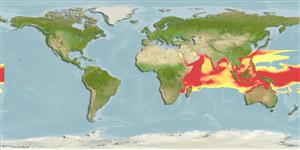Issue
This species is considered as a junior synonym of Mobula kuhlii according to White et al., 2017 (Ref. 115945:9). The species page will be removed,.
Environment: milieu / climate zone / depth range / distribution range
Ekologi
laut; kisaran kedalaman 0 - 50 m (Ref. 106604). Tropical; 30°N - 21°S
Indo-West Pacific: Red Sea, Arabian Sea and the Persian Gulf to South Africa and the Philippines, north to Viet Nam, south to northern Australia (Ref. 9911). This species is noted as a possible synonym of the earlier Mobula diabolus (Shaw, 1804) in Compagno's 1999 checklist (Ref. 35766).
Size / Weight / umur
Maturity: Lm ? range ? - ? cm
Max length : 100.0 cm WD jantan/; (Ref. 6871)
deskripsi pendek
Morfologi | Morfometrik
Brownish-grey above, whitish below (Ref. 11228). Underside of pectorals with semicircular black blotch along middle of anterior edge (Ref. 11228).
Found in coastal and oceanic waters (Ref. 30573); solitary of aggregations, sometimes with 50 or more individuals (Ref. 90102). Not known to penetrate the epipelagic zone (Ref. 9911). Feeds on plankton (Ref. 30573). Ovoviviparous (Ref. 50449).
Life cycle and mating behavior
Kematangan | Reproduksi, perkembang biakan | Pemijahan | telur-telur | Fecundity | Larva
Exhibit ovoviparity (aplacental viviparity), with embryos feeding initially on yolk, then receiving additional nourishment from the mother by indirect absorption of uterine fluid enriched with mucus, fat or protein through specialised structures (Ref. 50449).
Compagno, L.J.V., 1999. Checklist of living elasmobranchs. p. 471-498. In W.C. Hamlett (ed.) Sharks, skates, and rays: the biology of elasmobranch fishes. Johns Hopkins University Press, Maryland. (Ref. 35766)
Status IUCN Red List (Ref. 130435)
ancaman kepada manusia
Harmless
penggunaan manusia
informasi lanjut
Umur / SaizPertumbuhanpanjang-beratpanjang-panjangukuran frekuensiMorfometrikMorfologiLarvaDinamika larvapemulihanKelimpahanBRUVS
AcuanBudidaya airprofil budidaya airStrainGenetikaElectrophoresesDiturunkanPenyakit-penyakitPengolahanNutrientsMass conversion
mitraGambarStamps, Coins Misc.Suara-suaraCiguateraKecepatanTipe renangArea insangOtolithsOtakPenglihatan / visi
Alat, peralatan
laporan khas
muat turun XML
Sumber internet
Estimates based on models
Preferred temperature (Ref.
123201): 25.6 - 29.1, mean 28.2 °C (based on 2136 cells).
Phylogenetic diversity index (Ref.
82804): PD
50 = 0.5005 [Uniqueness, from 0.5 = low to 2.0 = high].
Bayesian length-weight: a=0.01000 (0.00244 - 0.04107), b=3.04 (2.81 - 3.27), in cm total length, based on all LWR estimates for this body shape (Ref.
93245).
Trophic level (Ref.
69278): 3.4 ±0.45 se; based on food items.
Daya lenting (Ref.
120179): Rendah, Waktu penggandaan populasi minimum 4.5 - 14 tahun (Fec assumed to be <100).
Fishing Vulnerability (Ref.
59153): Very high vulnerability (85 of 100).
Nutrients (Ref.
124155): Calcium = 26.5 [7.6, 139.1] mg/100g; Iron = 0.962 [0.235, 2.819] mg/100g; Protein = 21 [16, 26] %; Omega3 = 0.184 [0.050, 0.609] g/100g; Selenium = 50.2 [13.3, 160.3] μg/100g; VitaminA = 23.1 [7.7, 73.7] μg/100g; Zinc = 0.942 [0.449, 1.798] mg/100g (wet weight);
